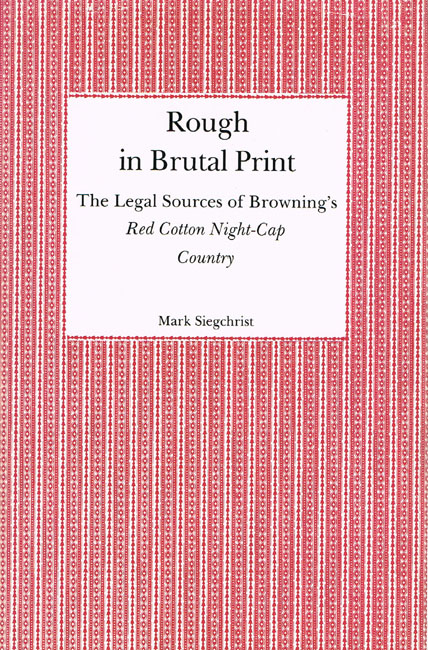Rough in Brutal PrintThe Legal Sources of Browning’s “Red Cotton Night-Cap Country”Mark Siegchrist |
 1981 Literary Criticism / European / English, Irish, Scottish, Welsh; Literary Criticism / Poetry 187 pp. 6x9  $24.95 paper 978-0-8142-5353-3 Add paper to shopping cart Shopping Cart Instructions Review/Change Shopping Cart & Check-out | |||
|
On March 8, 1873, Robert Browning asserted in a letter to his publisher: “I premise, and wish to have distinctly borne in mind by any reader of this poem, that it is no more nor less than a mere account treated poetically, of certain problematic facts taken just as I find them given, by parties to a dispute, in the published pleadings of their respective legal advocates and the formal decision of a Court of Law.” The poem that was the subject of this insistent defense was Browning’s Red Cotton Night-Cap Country, which is generally regarded as the finest long work he produced following the celebrated The Ring and the Book of 1868–69. As he had in that earlier masterpiece, Browning undertook again to deal with an actual historical event. In The Ring and the Book, it is well known, he revived a lurid if obscure Italian crime of the seventeenth century. In Red Cotton Night-Cap Country, he turned to an episode that was equally shocking but considerably closer in time: a contemporary French scandal involving an illicit love affair, self–mutilation, and a mysterious and troubling death. It was the poet’s intention in both these works to rescue from beneath the distorting crust of the public record the essential truth that is apprehensible to the imagination alone. In both works, he alludes frequently to the hisoricity of the facts that had sparked his imagination, emphasizes repeatedly his reliance in both works on testimony publicly available, and reminds the reader over and over that his poem records objective facts with absolute fidelity. By examining that record in minute detail and sifting through for himself the original legal documents from which Browning worked, Professor Siegchrist is able to demonstrate conclusively that the poet’s claims to have been absolutely faithful to the “pure crude fact” that inspired him are calculatedly false. In The Ring and the Book, deviations from the sources Browning consulted are of little real consequence; for they affect only marginally the poem’s general meaning. In Red Cotton Night-Cap Country, however, his many departures from the vulgar facts “reported in the newspaper,” and his trust in the power of the imagination to perceive the truths obscured under public documentation, result in a distortion that lies at the very heart of the dilemma posed him by those materials – materials that stubbornly resisted his efforts to shape them in obedience to the themes he desired them to embody. In his insistence that his art was not a transformation of reality into fiction, but a resuscitation of that reality, Browning encountered problems in literary practice that he was never successfully to resolve. In his compelling analysis of the substance and dimensions of the poet’s creative predicament, Dr. Siegchrist reveals much about the nature of art as process, and its always problematic and elusive relation to life, as life presents itself, and is represented, in our self-serviing perceptions and purposeful imaginings. Mark Siegchrist is assistant professor of English at Marquette University in Milwaukee, Wisconsin. | ||||

